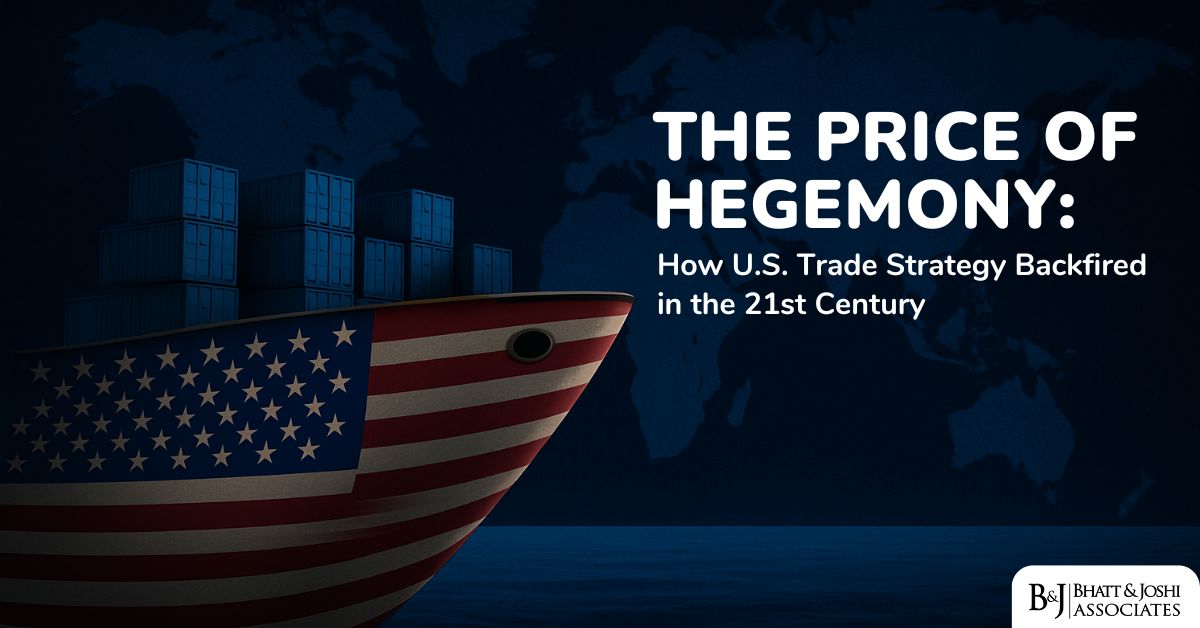Introduction
The story of America’s trade strategy in the 21st century represents a cautionary tale about the unintended consequences of economic hegemony. What began as a carefully crafted system of global trade dominance, designed to cement U.S. economic leadership while promoting allied prosperity, has increasingly turned against its architect. This transformation reveals how policies intended to maintain American supremacy ultimately contributed to its relative decline, creating vulnerabilities that competitors have skillfully exploited. The irony of this situation lies in how the very tools and institutions the United States created to maintain its economic leadership have become instruments of its competitive disadvantage. This paper examines how U.S. trade strategy backfired, a strategy born in the crucible of post-war prosperity, in ways that its architects could scarcely have imagined.
The Foundation of U.S. Trade Hegemony
Post-War Economic Architecture
In the aftermath of World War II, the United States established an international economic order designed to prevent the return of the destructive trade policies of the 1930s while ensuring American economic predominance. The Bretton Woods Conference of 1944 created the International Monetary Fund (IMF) and the World Bank, institutions that would promote monetary stability and economic development under U.S. leadership.
The genius of this system lay in its ability to combine American interests with global economic growth. By providing economic stability and market access to allies, the U.S. created a network of prosperous trading partners while maintaining its position at the apex of the global economy.
Global Monetary Control
The dollar-based monetary system gave the United States unprecedented control over global finance. By making the dollar convertible to gold at $35 per ounce, while other currencies were pegged to the dollar, America gained what French President Charles de Gaulle called an “exorbitant privilege” – the ability to run persistent deficits without immediate consequences.
This monetary dominance allowed the U.S. to exercise soft power through financial channels, influencing global economic behavior through control of the world’s primary reserve and trading currency.
Strategic Trade Liberalization
The United States promoted trade liberalization selectively, opening markets where it held competitive advantages while maintaining protection for sensitive industries. This approach, combined with America’s technological and productive superiority, created a trading system that disproportionately benefited U.S. interests.
Building the Trade Empire
The GATT System
The General Agreement on Tariffs and Trade (GATT) served as the primary instrument for expanding U.S.-led trade liberalization. Through successive rounds of negotiations, average tariffs among industrial countries fell from about 40% in 1947 to less than 5% by the early 1990s.
The Kennedy Round (1964-1967) and Tokyo Round (1973-1979) of GATT negotiations particularly exemplified America’s ability to shape global trade rules to its advantage, focusing on areas where U.S. companies held competitive edges while maintaining protection for sensitive sectors.
WTO Formation and Expansion
The creation of the World Trade Organization (WTO) in 1995 marked the apex of U.S. trade strategy. The new organization provided stronger enforcement mechanisms and expanded trade rules into services, intellectual property, and investment measures. However, it also created a more rigid system that would later constrain U.S. policy options.
Most Favored Nation Politics
The selective application of Most Favored Nation (MFN) status became a powerful tool of U.S. foreign policy. By controlling access to the American market, the U.S. could influence other nations’ domestic and foreign policies. The annual renewal of China’s MFN status throughout the 1990s exemplified this approach.
Tools of Economic Dominance
Dollar Supremacy
The dollar’s role as the global reserve currency provided the United States with significant advantages:
- The ability to fund deficits through dollar-denominated debt
- Control over global payment systems
- Influence over international trade financing
This monetary power allowed the U.S. to impose effective economic sanctions and influence global economic behavior.
Financial Market Control
Wall Street’s dominance of global financial markets gave the U.S. additional leverage over the international economy. American financial institutions became the primary intermediaries for global trade and investment, while U.S. regulatory standards became de facto global norms.
Technological Leadership
American technological superiority in key industries like semiconductors, software, and aerospace reinforced U.S. economic leadership. Control over critical technologies allowed the U.S. to maintain advantages in high-value sectors of the global economy.
The Rise of Strategic Competitors
China’s Economic Awakening
China’s economic reform and opening, beginning in 1978, initially appeared to align with U.S. interests. However, China’s strategic approach to development, combining market access with state direction and technology acquisition, ultimately challenged U.S. economic leadership.
The scale of China’s success exceeded all American projections. By 2021, China had become:
- The world’s largest manufacturing nation
- The leading trading partner for most countries
- A serious competitor in advanced technologies
European Union Integration
European economic integration created a trading bloc capable of negotiating with the U.S. on equal terms. The EU’s common market and currency reduced European dependency on U.S. markets and monetary policy, while creating a alternative power center in global trade negotiations.
Emerging Market Dynamics
The rise of emerging markets, particularly the BRICS nations (Brazil, Russia, India, China, and South Africa), created new centers of economic power less dependent on U.S. leadership. These countries increasingly challenged U.S. positions in trade negotiations and developed alternative economic institutions.
Strategic Miscalculations in U.S. Trade Policy
The China Trade Gambit
The decision to support China’s WTO accession in 2001 rested on several assumptions that proved incorrect:
- That economic liberalization would lead to political liberalization
- That China would accept a subordinate role in the U.S.-led economic order
- That U.S. companies could maintain technological advantages
Instead, China used WTO membership to accelerate its development while maintaining state control over strategic sectors.
Outsourcing and Industrial Decline
The massive outsourcing of U.S. manufacturing, while profitable for individual companies, created strategic vulnerabilities:
- Loss of industrial capabilities
- Erosion of the manufacturing workforce
- Dependence on foreign suppliers
- Transfer of technological expertise
Innovation Transfer Consequences
U.S. policy underestimated the long-term consequences of technology transfer through:
- Joint venture requirements
- Intellectual property theft
- Reverse engineering
- Talent recruitment
These transfers accelerated the development of foreign competitors in key industries.
How the U.S. Trade Strategy Backfired: The Ripple Effects
Trade Deficit Spiral
The persistent U.S. trade deficit became structural rather than cyclical, reaching unprecedented levels:
- Over $1 trillion annual deficit by 2022
- Growing dependence on foreign financing
- Increased vulnerability to external economic pressure
Manufacturing Erosion
The decline of U.S. manufacturing capacity has had cascading effects:
- Loss of innovation capacity
- Reduced workforce skills
- Regional economic decline
- Supply chain vulnerabilities
Technology Competition
One clear example of how the U.S. trade strategy backfired is the erosion of its technological leadership, seen in developments such as:
- Chinese advances in 5G, AI, and quantum computing
- European leadership in certain green technologies
- Competition in semiconductor manufacturing
Current State of U.S. Trade Power
Declining Market Share
U.S. share of global exports has fallen dramatically:
- From about 40% in 1950 to less than 10% today
- Reduced influence in key markets
- Growing competition in high-tech sectors
Supply Chain Vulnerabilities
The COVID-19 pandemic exposed critical weaknesses:
- Dependence on foreign medical supplies
- Semiconductor shortages
- Rare earth element supplies
- Strategic material access
Strategic Industry Losses
Key industrial sectors have seen serious erosion:
- Semiconductor manufacturing
- Telecommunications equipment
- Consumer electronics
- Advanced materials
Future Outlook and Policy Options for U.S. Trade Strategy
Reshoring Initiatives
Recent policies aim to rebuild domestic production:
- CHIPS Act for semiconductor manufacturing
- Clean energy manufacturing incentives
- Critical mineral production support
Strategic Industry Protection
New approaches to protecting key industries include:
- Enhanced investment screening
- Export controls on critical technologies
- Support for strategic sectors
New Trade Partnerships
Efforts to build new trade alliances focus on:
- Indo-Pacific Economic Framework
- Technology partnerships with allies
- Supply chain resilience agreements
Conclusion
The backfiring of U.S. trade strategy represents a classic case of policy makers failing to anticipate how their own success would create the conditions for decline. The institutions and practices established to maintain American economic hegemony ultimately provided tools and opportunities for competitors to challenge that very dominance.
Moving forward, the United States faces the challenge of adapting its trade strategy to a multipolar economic world while addressing the vulnerabilities created by past policies. Success will require balancing the benefits of global economic integration with the need to maintain critical domestic capabilities and protect strategic interests.
he experience offers important lessons about the limits of economic hegemony and the need for more nuanced approaches to trade policy. As the United States navigates these challenges, it must find ways to maintain economic competitiveness without repeating the mistakes that led to the U.S. trade strategy backfired scenario of the early 21st century.














